Characterization of Transient Receptor Potential Vanilloid-1 (TRPV1) Variant Activation by Coal Fly Ash Particles and Associations with Altered Transient Receptor Potential Ankyrin-1 (TRPA1) Expression and Asthma
- PMID: 27758864
- PMCID: PMC5122759
- DOI: 10.1074/jbc.M116.746156
Characterization of Transient Receptor Potential Vanilloid-1 (TRPV1) Variant Activation by Coal Fly Ash Particles and Associations with Altered Transient Receptor Potential Ankyrin-1 (TRPA1) Expression and Asthma
Abstract
Transient receptor potential (TRP) channels are activated by environmental particulate materials. We hypothesized that polymorphic variants of transient receptor potential vanilloid-1 (TRPV1) would be uniquely responsive to insoluble coal fly ash compared with the prototypical soluble agonist capsaicin. Furthermore, these changes would manifest as differences in lung cell responses to these agonists and perhaps correlate with changes in asthma symptom control. The TRPV1-I315M and -T469I variants were more responsive to capsaicin and coal fly ash. The I585V variant was less responsive to coal fly ash particles due to reduced translation of protein and an apparent role for Ile-585 in activation by particles. In HEK-293 cells, I585V had an inhibitory effect on wild-type TRPV1 expression, activation, and internalization/agonist-induced desensitization. In normal human bronchial epithelial cells, IL-8 secretion in response to coal fly ash treatment was reduced for cells heterozygous for TRPV1-I585V. Finally, both the I315M and I585V variants were associated with worse asthma symptom control with the effects of I315M manifesting in mild asthma and those of the I585V variant manifesting in severe, steroid-insensitive individuals. This effect may be due in part to increased transient receptor potential ankyrin-1 (TRPA1) expression by lung epithelial cells expressing the TRPV1-I585V variant. These findings suggest that specific molecular interactions control TRPV1 activation by particles, differential activation, and desensitization of TRPV1 by particles and/or other agonists, and cellular changes in the expression of TRPA1 as a result of I585V expression could contribute to variations in asthma symptom control.
Keywords: Western blot; asthma; inflammation; single nucleotide polymorphism (SNP); transient receptor potential channels (TRP channels).
© 2016 by The American Society for Biochemistry and Molecular Biology, Inc.
Figures
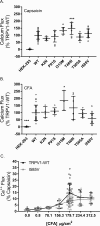


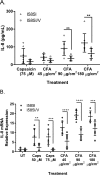
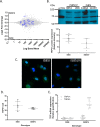
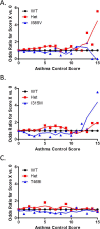

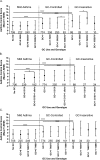
Similar articles
-
Mechanisms and Consequences of Variable TRPA1 Expression by Airway Epithelial Cells: Effects of TRPV1 Genotype and Environmental Agonists on Cellular Responses to Pollutants in Vitro and Asthma.Environ Health Perspect. 2023 Feb;131(2):27009. doi: 10.1289/EHP11076. Epub 2023 Feb 27. Environ Health Perspect. 2023. PMID: 36847817 Free PMC article.
-
Activation of Transient Receptor Potential Ankyrin-1 by Insoluble Particulate Material and Association with Asthma.Am J Respir Cell Mol Biol. 2015 Dec;53(6):893-901. doi: 10.1165/rcmb.2015-0086OC. Am J Respir Cell Mol Biol. 2015. PMID: 26039217 Free PMC article.
-
Transient receptor potential ankyrin 1 channel localized to non-neuronal airway cells promotes non-neurogenic inflammation.PLoS One. 2012;7(8):e42454. doi: 10.1371/journal.pone.0042454. Epub 2012 Aug 14. PLoS One. 2012. PMID: 22905134 Free PMC article.
-
Interaction between TRPA1 and TRPV1: Synergy on pulmonary sensory nerves.Pulm Pharmacol Ther. 2015 Dec;35:87-93. doi: 10.1016/j.pupt.2015.08.003. Epub 2015 Aug 14. Pulm Pharmacol Ther. 2015. PMID: 26283426 Free PMC article. Review.
-
Breathtaking TRP channels: TRPA1 and TRPV1 in airway chemosensation and reflex control.Physiology (Bethesda). 2008 Dec;23:360-70. doi: 10.1152/physiol.00026.2008. Physiology (Bethesda). 2008. PMID: 19074743 Free PMC article. Review.
Cited by
-
Mechanisms and Consequences of Variable TRPA1 Expression by Airway Epithelial Cells: Effects of TRPV1 Genotype and Environmental Agonists on Cellular Responses to Pollutants in Vitro and Asthma.Environ Health Perspect. 2023 Feb;131(2):27009. doi: 10.1289/EHP11076. Epub 2023 Feb 27. Environ Health Perspect. 2023. PMID: 36847817 Free PMC article.
-
Pro-inflammatory effects of inhaled Great Salt Lake dust particles.Part Fibre Toxicol. 2025 Jan 16;22(1):2. doi: 10.1186/s12989-025-00618-9. Part Fibre Toxicol. 2025. PMID: 39819386 Free PMC article.
-
Wood Smoke Particles Stimulate MUC5AC Overproduction by Human Bronchial Epithelial Cells Through TRPA1 and EGFR Signaling.Toxicol Sci. 2020 Apr 1;174(2):278-290. doi: 10.1093/toxsci/kfaa006. Toxicol Sci. 2020. PMID: 31944254 Free PMC article.
-
TRP Channels as Cellular Targets of Particulate Matter.Int J Mol Sci. 2021 Mar 9;22(5):2783. doi: 10.3390/ijms22052783. Int J Mol Sci. 2021. PMID: 33803491 Free PMC article. Review.
-
Effect of traffic-related air pollution on cough in adults with polymorphisms in several cough-related genes.Respir Res. 2022 May 4;23(1):113. doi: 10.1186/s12931-022-02031-8. Respir Res. 2022. PMID: 35509099 Free PMC article.
References
-
- Allen R. W., Mar T., Koenig J., Liu L. J., Gould T., Simpson C., and Larson T. (2008) Changes in lung function and airway inflammation among asthmatic children residing in a woodsmoke-impacted urban area. Inhal. Toxicol. 20, 423–433 - PubMed
-
- Epton M. J., Dawson R. D., Brooks W. M., Kingham S., Aberkane T., Cavanagh J. A., Frampton C. M., Hewitt T., Cook J. M., McLeod S., McCartin F., Trought K., and Brown L. (2008) The effect of ambient air pollution on respiratory health of school children: a panel study. Environ. Health. 7, 16. - PMC - PubMed
-
- Iskandar A., Andersen Z. J., Bønnelykke K., Ellermann T., Andersen K. K., and Bisgaard H. (2012) Coarse and fine particles but not ultrafine particles in urban air trigger hospital admission for asthma in children. Thorax 67, 252–257 - PubMed
-
- Jacquemin B., Sunyer J., Forsberg B., Aguilera I., Bouso L., Briggs D., de Marco R., García-Esteban R., Heinrich J., Jarvis D., Maldonado J. A., Payo F., Rage E., Vienneau D., and Künzli N. (2009) Association between modelled traffic-related air pollution and asthma score in the ECRHS. Eur. Respir. J. 34, 834–842 - PubMed
MeSH terms
Substances
Grants and funding
LinkOut - more resources
Full Text Sources
Other Literature Sources
Medical
Molecular Biology Databases
Research Materials
Miscellaneous

